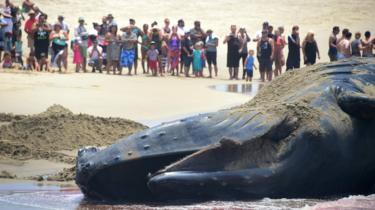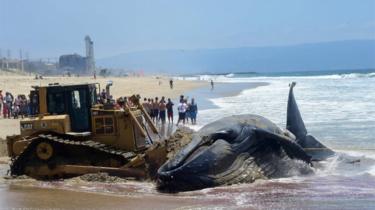Tuesday, October 25, 2016
Wally the whale Battle to remove carcass from US beach
Wally the whale Battle to remove carcass from US beach
 Going to the beach became a smelly affair for local residents after Wally repeatedly washed up after being towed out to sea.
Going to the beach became a smelly affair for local residents after Wally repeatedly washed up after being towed out to sea.
The body of a humpback whale has been removed from a beach in California after a long battle with the 22-tonne (48,500lb) carcass for 19 days.
The 45-foot (14m) whale, known locally as Wally, was first spotted dead in Los Angeles County on 30 June.
Efforts to drag it out to sea failed when the carcass kept washing up on various beaches in the area over the days that followed.
It was finally buried in a landfill site on Monday morning.
While alive, Wally was a regular visitor off the coast near San Diego.
The female whale, which was approximately 15 years old, was regularly seen by photographers breaching and rising to the surface.
 The whale, one of the worlds largest species, could be smelt for miles around after decaying for 19 days in the sun.
The whale, one of the worlds largest species, could be smelt for miles around after decaying for 19 days in the sun.
One video, captured last summer, shows her spraying water from her blowhole, creating the effect of a rainbow. It has been viewed more than a million times on YouTube.
Wallys days were less graceful in death.
After first washing up on Dockweiler State Beach, the whales body grew increasingly putrid as officials struggled to successfully tow it back to sea.
 Initially, officials tried dragging the whale out to sea with tow ropes. Pictured here is a first shove with a digger.
Initially, officials tried dragging the whale out to sea with tow ropes. Pictured here is a first shove with a digger.
"You can smell it up to about a quarter-mile away," Larry Giles, Marine Safety Captain in Encinitas, said in an interview with The San Diego Union Tribune at the time.
On Sunday, a construction crew attempted to cut up the body into pieces to remove it more easily. But under the weight of Wallys blubber, their forklift truck snapped, forcing them to rethink their approach.
The carcass was eventually removed from Grandview Beach using three large rubbish bins and a digger.
The jelly-like 45 foot whale was difficult to remove, even after being cut up into three pieces by a construction crew.
The cause of Wallys death is unknown, although the Los Angeles Times has reported that the animal was covered with whale lice, which can be a sign of poor health.
Humpback whales are found in every ocean around the world, congregating in their thousands off the coast of California each winter.
Source:BBCNEWS
Available link for download